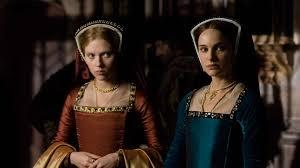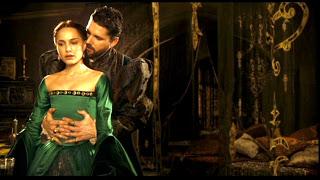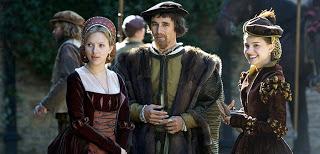 Interest in the Tudors never dies, allowing each generation a chance to relive Henry VIII's Great Matter and Elizabeth's Golden Age through tony bodice rippers playing at history. Justin Chadwick's The Other Boleyn Girl (2008) isn't the most outrageous - it's positively classy next to The Tudors or Anonymous - but neither is it compelling. Beyond the pretty cast and mise-en-scene, there's little that hasn't been done far better elsewhere.
Interest in the Tudors never dies, allowing each generation a chance to relive Henry VIII's Great Matter and Elizabeth's Golden Age through tony bodice rippers playing at history. Justin Chadwick's The Other Boleyn Girl (2008) isn't the most outrageous - it's positively classy next to The Tudors or Anonymous - but neither is it compelling. Beyond the pretty cast and mise-en-scene, there's little that hasn't been done far better elsewhere.Anne (Natalie Portman) and Mary Boleyn (Scarlett Johansson) are daughters to Sir Thomas Boleyn (Mark Rylance), a minor nobleman in Henry VIII's (Eric Bana) court. At the urging of their uncle, the Duke of Norfolk (David Morrissey), Mary becomes the King's mistress, but finds his affection waning after she becomes pregnant. Then Henry turns to Anne, headstrong, worldly and ambitious, who refuses to bed the King unless he marries her. This sets in motion a momentous chain of events that severs England from Rome and Anne's head from her body.
Based on Philippa Gregory's soapy best-seller, The Other Boleyn Girl at least tries an alternate perspective on well-trod events. Problem is, Gregory's sister dynamic isn't especially compelling. Anne and Mary are easily defined types, demure and ambitious, respectively, which doesn't allow much room for development or nuance. Their relationship goes from chortling over Mary's husband's (Benedict Cumberbatch) fussiness to stabbing each other in the back; Mary's branded a whore for sleeping with Henry, while Anne controls him by denying her essence.
Artists have long struggled with Anne Boleyn, invariably painting her as either a witching harlot or an innocent victim of royal whims. Peter Morgan folds all the innuendos of ambition, incest and witchcraft into his script, turning Anne into history's biggest cock-tease while beatifying her sister. We're surprised she lacks her fabled sixth finger, though that would neuter the effect of ravishing Natalie Portman dragging Henry, England and herself into oblivion. Even when an impatient Henry rapes her, in Boleyn's wack moral calculus, Anne has it coming.
 Whether through laziness or disinterest, the momentous events of Henry's reign - his divorce from Catherine of Aragon (Ana Torent), break with Rome and English Reformation - remain largely off-screen: familiar figures from the Tudor era are completely absent (Cardinal Wolsey, Sir Thomas More) or reduced to walk-ons (Thomas Cromwell). There's no sense of the historical that usually gives weight to Henry stories: even The Tudors, thanks to its serialized format, allows viewers some appreciation of England's court scheming and social changes between Henry's amorous escapades. All Boleyn cares about is pretty girls battling each other for studly Prince Harry.
Whether through laziness or disinterest, the momentous events of Henry's reign - his divorce from Catherine of Aragon (Ana Torent), break with Rome and English Reformation - remain largely off-screen: familiar figures from the Tudor era are completely absent (Cardinal Wolsey, Sir Thomas More) or reduced to walk-ons (Thomas Cromwell). There's no sense of the historical that usually gives weight to Henry stories: even The Tudors, thanks to its serialized format, allows viewers some appreciation of England's court scheming and social changes between Henry's amorous escapades. All Boleyn cares about is pretty girls battling each other for studly Prince Harry.Admittedly, some scenes strive towards a more nuanced story of women suffering in an ultra-masculine age, where sex and marriage offered the only methods for advancement, and men traded daughters like pawns. This is evident in Ana Torent's regal, endlessly dignified Catherine of Aragon, who defies Anne and her husband alike; Lady Elizabeth (Kristin Scott Thomas) agonizing over her daughters' plight and husband's weakness; even Anne gains sympathy when her failure to produce a son dooms her. If Gregory and the filmmakers intended a feminist revision of Tudor history, their simplistic dynamics betray them.
There are certainly delights for fans of costume dramas: the costumes themselves for one, especially Anne's emerald dress with regal trimmings, used to striking effect in her trial (set against the red of Henry's courtiers) and execution. Kieran McGuan's gorgeous photography bathes scenes in lush colors: sepia for the Boleyn estate, lush green-and-gold for Henry's court, forbidding blue-gray for courtrooms and council meetings. Along with Paul Cantelon's sweeping score, it ensures that Boleyn is watchable.
 Natalie Portman (with a far better English accent than in V for Vendetta) enjoys herself, making Anne sultry, headstrong and hateful until she turns suddenly sympathetic. It's not much on paper, but Portman's committed acting finds some humanity among the caricature. Scarlett Johansson reprises her passive, pensive performance from Girl with a Pearl Earring, which doesn't work here: alluring though she is in Renaissance costume, she's dull and out of place. Her role desperately needs some fire or passion; Johansson only offers moist pathos.
Natalie Portman (with a far better English accent than in V for Vendetta) enjoys herself, making Anne sultry, headstrong and hateful until she turns suddenly sympathetic. It's not much on paper, but Portman's committed acting finds some humanity among the caricature. Scarlett Johansson reprises her passive, pensive performance from Girl with a Pearl Earring, which doesn't work here: alluring though she is in Renaissance costume, she's dull and out of place. Her role desperately needs some fire or passion; Johansson only offers moist pathos.Eric Bana gets the thankless role of playing Henry as a glowering monster: he's possibly the least interesting screen Henry to date. Ana Torent and Kristin Scott Thomas mine their minor roles for grace notes and come out unscathed. There's a veritable smorgasbord of up-and-coming English talent in support: Benedict Cumberbatch, Andrew Garfield, Jim Sturgess, Juno Temple, Mark Rylance and Eddie Redmayne. Sadly, few of them have much to do.
At best, The Other Boleyn Girl is a poor man's Anne of the Thousand Days, down to the clunky epilogue announcing that Anne's daughter became Elizabeth I. If that movie decides to simplify history, at least it makes Anne compelling. Not every Tudor movie can be A Man for All Seasons, but they should strive to be more than a well-shot Harlequin novel.

